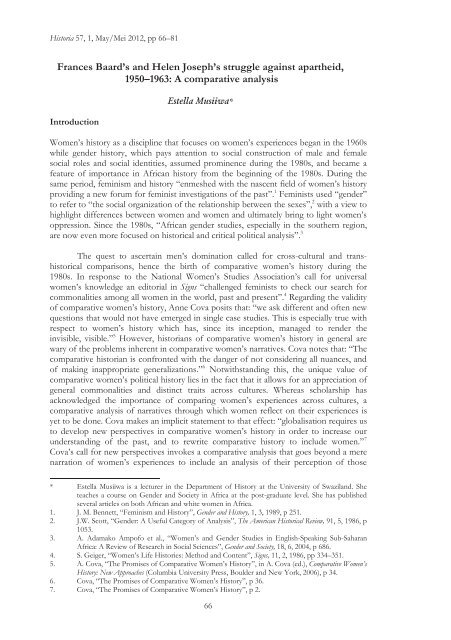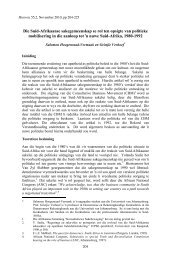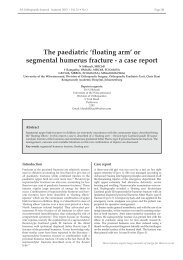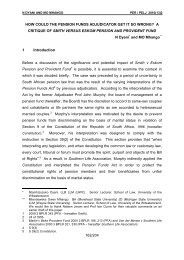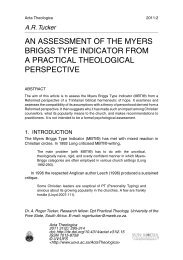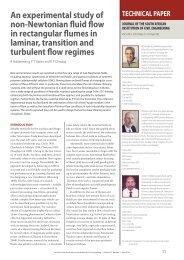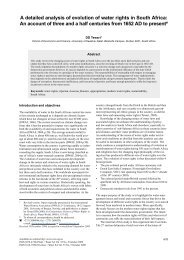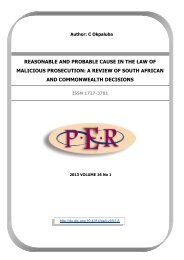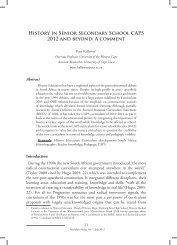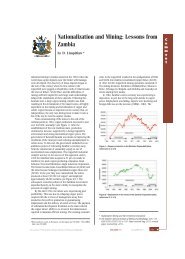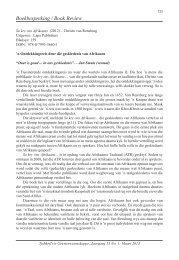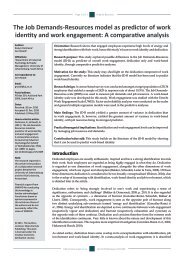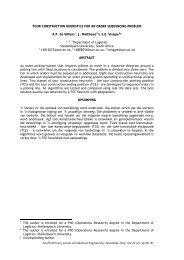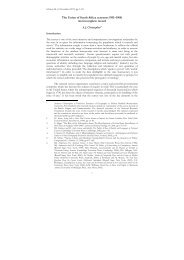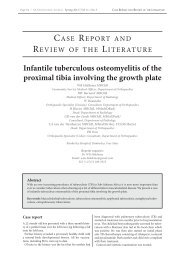Frances Baard's and Helen Joseph's struggle against apartheid ...
Frances Baard's and Helen Joseph's struggle against apartheid ...
Frances Baard's and Helen Joseph's struggle against apartheid ...
You also want an ePaper? Increase the reach of your titles
YUMPU automatically turns print PDFs into web optimized ePapers that Google loves.
Historia 57, 1, May/Mei 2012, pp 66–81<br />
<strong>Frances</strong> Baard’s <strong>and</strong> <strong>Helen</strong> Joseph’s <strong>struggle</strong> <strong>against</strong> <strong>apartheid</strong>,<br />
1950–1963: A comparative analysis<br />
Introduction<br />
Estella Musiiwa*<br />
Women’s history as a discipline that focuses on women’s experiences began in the 1960s<br />
while gender history, which pays attention to social construction of male <strong>and</strong> female<br />
social roles <strong>and</strong> social identities, assumed prominence during the 1980s, <strong>and</strong> became a<br />
feature of importance in African history from the beginning of the 1980s. During the<br />
same period, feminism <strong>and</strong> history “enmeshed with the nascent field of women’s history<br />
providing a new forum for feminist investigations of the past”. 1 Feminists used “gender”<br />
to refer to “the social organization of the relationship between the sexes”, 2 with a view to<br />
highlight differences between women <strong>and</strong> women <strong>and</strong> ultimately bring to light women’s<br />
oppression. Since the 1980s, “African gender studies, especially in the southern region,<br />
are now even more focused on historical <strong>and</strong> critical political analysis”. 3<br />
The quest to ascertain men’s domination called for cross-cultural <strong>and</strong> transhistorical<br />
comparisons, hence the birth of comparative women’s history during the<br />
1980s. In response to the National Women’s Studies Association’s call for universal<br />
women’s knowledge an editorial in Signs “challenged feminists to check our search for<br />
commonalities among all women in the world, past <strong>and</strong> present”. 4 Regarding the validity<br />
of comparative women’s history, Anne Cova posits that: “we ask different <strong>and</strong> often new<br />
questions that would not have emerged in single case studies. This is especially true with<br />
respect to women’s history which has, since its inception, managed to render the<br />
invisible, visible.” 5 However, historians of comparative women’s history in general are<br />
wary of the problems inherent in comparative women’s narratives. Cova notes that: “The<br />
comparative historian is confronted with the danger of not considering all nuances, <strong>and</strong><br />
of making inappropriate generalizations.” 6 Notwithst<strong>and</strong>ing this, the unique value of<br />
comparative women’s political history lies in the fact that it allows for an appreciation of<br />
general commonalities <strong>and</strong> distinct traits across cultures. Whereas scholarship has<br />
acknowledged the importance of comparing women’s experiences across cultures, a<br />
comparative analysis of narratives through which women reflect on their experiences is<br />
yet to be done. Cova makes an implicit statement to that effect: “globalisation requires us<br />
to develop new perspectives in comparative women’s history in order to increase our<br />
underst<strong>and</strong>ing of the past, <strong>and</strong> to rewrite comparative history to include women.” 7<br />
Cova’s call for new perspectives invokes a comparative analysis that goes beyond a mere<br />
narration of women’s experiences to include an analysis of their perception of those<br />
* Estella Musiiwa is a lecturer in the Department of History at the University of Swazil<strong>and</strong>. She<br />
teaches a course on Gender <strong>and</strong> Society in Africa at the post-graduate level. She has published<br />
several articles on both African <strong>and</strong> white women in Africa.<br />
1. J. M. Bennett, “Feminism <strong>and</strong> History”, Gender <strong>and</strong> History, 1, 3, 1989, p 251.<br />
2. J.W. Scott, “Gender: A Useful Category of Analysis”, The American Historical Review, 91, 5, 1986, p<br />
1053.<br />
3. A. Adamako Ampofo et al., “Women’s <strong>and</strong> Gender Studies in English-Speaking Sub-Saharan<br />
Africa: A Review of Research in Social Sciences”, Gender <strong>and</strong> Society, 18, 6, 2004, p 686.<br />
4. S. Geiger, “Women’s Life Histories: Method <strong>and</strong> Content”, Signs, 11, 2, 1986, pp 334–351.<br />
5. A. Cova, “The Promises of Comparative Women’s History”, in A. Cova (ed.), Comparative Women’s<br />
History: New Approaches (Columbia University Press, Boulder <strong>and</strong> New York, 2006), p 34.<br />
6. Cova, “The Promises of Comparative Women’s History”, p 36.<br />
7. Cova, “The Promises of Comparative Women’s History”, p 2.<br />
66
Musiiwa - <strong>Frances</strong> Baard’s <strong>and</strong> <strong>Helen</strong> Joseph’s <strong>struggle</strong><br />
experiences. In the light of this observation, this article intends to narrow down to a<br />
comparative analysis of the ways in which women perceive their experiences of the same<br />
phenomena, but from different methodological perspectives.<br />
The attempt to reconstruct history “from the bottom up” <strong>and</strong> the varieties of<br />
radical history that document social conflict from the point of view of the oppressed, has<br />
accorded personal narratives a strong impetus <strong>and</strong> has placed them in the forefront of<br />
women’s history. 8 As noted by Kathryn Anderson et al.: “Oral History is a basic tool in<br />
our efforts to incorporate the previously overlooked lives, activities <strong>and</strong> feelings of<br />
women into our underst<strong>and</strong>ing of the past <strong>and</strong> present.” 9 Beginning in the late 1980s,<br />
some of the scholars of African women’s history depended on life histories to recapture<br />
women’s voices because, according to Susan Geiger, “First, written records, whether<br />
colonial or African, are overwhelmingly <strong>and</strong>rocentric … With a few notable exceptions<br />
such documentation ignores women unless they cause trouble or constitute a problem.” 10<br />
Since then, women’s life histories have constituted an important source of information.<br />
As Jean Davison notes, “African women’s narratives provide a unique opportunity to<br />
grasp the concrete dailiness of their lives in the process of change”. 11 In fact, Akosua<br />
Adomako Ampofo et al. note that: “The use of various forms of historical methods, such<br />
as oral history <strong>and</strong> autobiographical <strong>and</strong> biographical studies, helped redefine<br />
conventional underst<strong>and</strong>ings of various historical events <strong>and</strong> processes.” 12 Given the<br />
prominence of qualitative research, life histories <strong>and</strong> autobiographies shed light on both<br />
the introspective <strong>and</strong> retrospective course of a life over time, <strong>and</strong> they provide room to<br />
interpret life in its historical <strong>and</strong> cultural contexts. While it is true that an underst<strong>and</strong>ing<br />
of the “insider” (emic) view is particularly important <strong>and</strong> a much needed corrective to the<br />
“outsider” (etic) approaches to theory, the use of autobiographies <strong>and</strong> life histories,<br />
which centre on the construction of selfhood, raises important methodological <strong>and</strong><br />
epistemological issues in comparative women’s political history. It is <strong>against</strong> this<br />
backdrop that the article seeks to appreciate the similarities <strong>and</strong> differences in women’s<br />
perception <strong>and</strong> representation of their experiences of the same phenomenon.<br />
This article centres on two political narratives, a South African woman’s<br />
autobiography <strong>and</strong> a South African woman’s life history. Both were published in 1986<br />
<strong>and</strong> are used to decipher the levels at which women’s perceptions of their experiences of<br />
the <strong>struggle</strong> <strong>against</strong> <strong>apartheid</strong> can be compared. The article focuses on the period<br />
between 1950, when the Defiance Campaign began, to 1961, when the African National<br />
Congress (ANC) was banned. My Spirit is Not Banned is a life history co-authored by<br />
<strong>Frances</strong> Baard, the narrator, <strong>and</strong> Barbie Schreiner, the editor. 13 <strong>Frances</strong> Baard was an<br />
African woman educated up to St<strong>and</strong>ard Six, who had two years of teacher training. She<br />
taught for two years after which she worked as a domestic servant. Later, when Baard<br />
8. Anthropologists have used life history as a source of information since the 1920s. For details on<br />
the origins <strong>and</strong> uses of life histories see L.C. Watson, “Underst<strong>and</strong>ing Life History as a Subjective<br />
Document: Hermeneutical <strong>and</strong> Phenomenological Perspectives”, Ethics, 4, 1, 1976, pp 95–131.<br />
9. K. Anderson et al., “Beginning where we Are: Feminist Methodology in Oral History”, The Oral<br />
History Review, 15, 1, 1987, p 104.<br />
10. S. Geiger, “Women in Nationalist Struggle: TANU Activists in Dar es Salaam”, The International<br />
Journal of African Historical Studies, 20, 1, 1987, p 3.<br />
11. J. Davison, Voices from Mutira: Change in the Lives of Rural Gikuyu Women, 1910–1995 (Boulder,<br />
Lynne Rienner , 1996), p 21.<br />
12. Adamako Ampofo et al, “Women’s <strong>and</strong> Gender Studies”, p 688.<br />
13. F. Baard <strong>and</strong> B. Schreiner, My Spirit is Not Banned: As Told by <strong>Frances</strong> Baard to Barbie Schreiner<br />
(Zimbabwe Publishing House, Harare, 1986). The source used in this article is the online version,<br />
available at http://v1.sahistory.org.za/pages/library-resources/onlinebooks/baard/resources.htm<br />
accessed 2 February 2012.<br />
67
Musiiwa - <strong>Frances</strong> Baard’s <strong>and</strong> <strong>Helen</strong> Joseph’s <strong>struggle</strong><br />
was working in a factory, Ray Alex<strong>and</strong>er, a prominent trade unionist, appointed her as a<br />
trade union leader. Now politicised, <strong>Frances</strong> became a co-founder of the ANC Women’s<br />
League in 1956.<br />
As the title implies, Side by Side: The Autobiography of <strong>Helen</strong> Joseph is <strong>Helen</strong> Joseph’s<br />
autobiography. 14 She was a white, middle-class liberal woman, who fought <strong>against</strong><br />
<strong>apartheid</strong> on behalf of Africans. She was exposed to the evils of <strong>apartheid</strong> when she<br />
became a social worker, but was initiated into the <strong>struggle</strong> <strong>against</strong> <strong>apartheid</strong> by Solly<br />
Sachs, a Jewish trade unionist. Baard <strong>and</strong> Joseph fought together, side by side. For Baard,<br />
it was on the basis of personal experiences of <strong>apartheid</strong> but for Joseph, it was on the<br />
basis of what she felt were <strong>apartheid</strong> injustices <strong>against</strong> Africans <strong>and</strong> people of colour.<br />
The two narratives were written specifically to highlight these women’s, <strong>and</strong><br />
other people’s experiences of the <strong>struggle</strong> <strong>against</strong> <strong>apartheid</strong>. According to Baard, “1959<br />
was declared Anti-Pass Year by the ANC in honour of the women because we fought so<br />
bravely <strong>against</strong> the passes. They said ‘Malibongwe Makosikazi!’ – ‘Let the women be<br />
praised!’” 15 Schreiner, the researcher, is more explicit: “This book does not only tell her<br />
story. It tells part of our history. It is a story that needs to be heard.” 16 She then explains<br />
why the story must be heard: “The 1958 ANC conference opened with a bright red<br />
banner, ‘Malibongwe Makhosikazi’ (‘Let the women be praised’).” Why the role of women<br />
was appreciated was explicit in the 1955 ANC National Executive Committee report:<br />
The women have been active in those major issues that most keenly affect them: Bantu<br />
Education, the threat of passes for women, the home, the children <strong>and</strong> the family. They<br />
have administered to us all a lesson on how the people’s daily needs can become the kernel<br />
of a united protest campaign so that even those not previously active in political affairs,<br />
feel compelled to join in. 17<br />
In essence, the banner <strong>and</strong> the ANC report foreground women’s issues as the driving<br />
force behind the <strong>struggle</strong> <strong>against</strong> <strong>apartheid</strong>.<br />
Likewise, <strong>Helen</strong> Joseph’s autobiography was written with a specific audience in<br />
mind. However, Joseph tends to differ with Baard in the sense that she perceives the<br />
anti- pass campaign from a transcendent unity of events, <strong>and</strong> more so, tends to be<br />
modest on the significance of this epoch in the trend of events that characterised the<br />
<strong>struggle</strong> for independence. As she notes:<br />
That was on 9 August 1956. Today, nearly thirty years later, it is celebrated as National<br />
Women’s Day, both here in South Africa amongst those who carry on the <strong>struggle</strong> for<br />
freedom <strong>and</strong> in other l<strong>and</strong>s where the liberation movement, led by the African National<br />
Congress, is known <strong>and</strong> honoured. 18<br />
While Baard attaches glamorous significance to the incident <strong>and</strong> presents it as a turning<br />
point in the history of South Africa’s liberation <strong>struggle</strong>, Joseph tends to be modest<br />
about its importance <strong>and</strong> notes:<br />
14. H. Joseph, Side by Side: The Autobiography of <strong>Helen</strong> Joseph (Zed Books, London, 1986). The online<br />
version used here is http://v1.sahistory.org.za/pages/library-resources/onlinebooks/side-byside/part-one-chapter.htm<br />
accessed 5 February 2012.<br />
15. Baard <strong>and</strong> Schreiner, My Spirit is Not Banned, Part 2.<br />
16. Baard <strong>and</strong> Schreiner, My Spirit is Not Banned, “Introduction”.<br />
17. As cited in Baard <strong>and</strong> Schreiner, My Spirit is Not Banned, “Introduction”.<br />
18. Joseph, Side by Side, Part 1, Chapter 10, “Trail by Detention”.<br />
68
Musiiwa - <strong>Frances</strong> Baard’s <strong>and</strong> <strong>Helen</strong> Joseph’s <strong>struggle</strong><br />
How it came to pass that we made our protest that day at the Union Buildings – the most<br />
hallowed seat of white government – is a small part, but nevertheless a part of the history<br />
of our country, South Africa. 19<br />
Both narratives carry a m<strong>and</strong>ate to fill a historical gap by telling a suppressed truth. As<br />
Schreiner explains, “The Nationalist [sic] government has attempted to suppress the<br />
truth <strong>and</strong> keep from us the real story of the people’s <strong>struggle</strong> for liberation. I hope that<br />
this book goes some way towards filling the gap.” 20 This truth that was deliberately<br />
repressed <strong>and</strong> was not captured in official documents, can be retrieved from women’s<br />
personal narratives. As Kathryn Anderson contends: “When women speak for<br />
themselves, they reveal hidden realities: new experiences <strong>and</strong> new perspectives emerge<br />
that challenge the ‘truths’ of official accounts …” 21 For Baard <strong>and</strong> Joseph, it is a truth<br />
that underscores women’s perception of their experiences of the <strong>struggle</strong> <strong>against</strong><br />
<strong>apartheid</strong>; the truth that the women’s anti-pass protest did not effect the phasing off of<br />
the pass law, but significantly realigned the policy <strong>and</strong> trajectory of the ANC. Not only<br />
does this truth emphasise the role of women, but it also redefines what finally came to<br />
constitute politics <strong>and</strong> how the political platform became gendered into both male <strong>and</strong><br />
female.<br />
Baard’s <strong>and</strong> Joseph’s narratives map out the trajectory of their experiences of the<br />
<strong>struggle</strong> <strong>against</strong> <strong>apartheid</strong> between the 1950s <strong>and</strong> the 1960s, yet they are marked with<br />
episodes of differences in unity. The first major difference is methodological, where<br />
Baard narrates her experiences of the <strong>struggle</strong> <strong>against</strong> <strong>apartheid</strong> to Schreiner, while<br />
Joseph writes an autobiographical recollection of her experiences of the same anti<strong>apartheid</strong><br />
<strong>struggle</strong>. The second issue is epistemological – to ascertain how the two<br />
women perceived their experiences of the <strong>struggle</strong> <strong>against</strong> <strong>apartheid</strong>.<br />
Methodological implications<br />
Definition<br />
L.C. Watson <strong>and</strong> M.B. Watson-Franke define personal narratives as<br />
a generic category including any expressive production of the individual that can be used<br />
to throw light on his view of himself, his life situation, or the state of the world as he<br />
underst<strong>and</strong>s it, at some particular point in time, or over the passage of time. 22<br />
Although they are retrospective personal accounts, life histories <strong>and</strong> autobiographies<br />
constitute different biographical genres. Watson <strong>and</strong> Watson-Franke define life history<br />
as, “any retrospective account by the individual of his/ her life in whole or part, in<br />
written or oral form, that has been elicited or prompted by another person”. 23 The whole life<br />
course is seen from the point of view of the person as she is currently trying to make<br />
sense of her relationship to past events, <strong>and</strong> the experience is usually recorded in the first<br />
person. 24 Though elicited by the researcher in the case of Baard’s testimony, the<br />
19. Joseph, Side by Side, Part 1, Chapter 1, “Twenty Thous<strong>and</strong> we March”.<br />
20. Baard <strong>and</strong> Schreiner, My Spirit is Not Banned, “Introduction”.<br />
21. Anderson et al, “Beginning where we Are”, p 104.<br />
22. L.C. Watson <strong>and</strong> M.B. Watson-Franke, Interpreting Life Histories: An Autobiographical Inquiry<br />
(Rutgers, New Jersey, 1985), p 2 (emphasis original).<br />
23. Watson <strong>and</strong> Watson-Franke, Interpreting Life Histories, p 2 (emphasis original).<br />
24. Some scholars have used both the first person <strong>and</strong> the third person. See S. Geiger, TANU Women:<br />
Gender <strong>and</strong> Culture in the Making of Tanganyikan Nationalism, 1955–1965 (Heinemann, Portsmouth,<br />
69
Musiiwa - <strong>Frances</strong> Baard’s <strong>and</strong> <strong>Helen</strong> Joseph’s <strong>struggle</strong><br />
distinguishing feature is that a life history is a joint production between the narrator <strong>and</strong><br />
the researcher, both of whose subjective views shape the body of knowledge ultimately<br />
produced. 25 While a life history is elicited by an outsider, an autobiography, as in Joseph’s<br />
case, is “a retrospective prose narrative written by a real person concerning his [or her]<br />
own existence, where the focus is his individual life, in particular the story of his<br />
personality”. 26 Such differences raise significant methodological implications in<br />
comparative political women’s history. With reference to biographical writing in general,<br />
Christopher Merrett notes that it is “rescuing the forgotten, the exiled <strong>and</strong> the<br />
marginalized from the repression <strong>and</strong> consequent obscurity of the past”. 27 Similarly,<br />
Margo V. Perkins notes that “activists use life-writing as an important tool for advancing<br />
political <strong>struggle</strong>”. 28<br />
The use of personal narratives in women’s political history is a subjective<br />
methodology underscored by the centrality of subjective consciousness through which<br />
the individual articulates her world. Geiger makes a valid claim that although personal<br />
narratives have been criticized as subjective, the value of this methodology actually lies in<br />
its subjectivity. 29 A life history <strong>and</strong> an autobiography are tied together through use of the<br />
subjective pronoun “I”, but they are characterised by marked structural differences. The<br />
fact that there is a distinction between the “I” who is “spoken of” in a life history<br />
recorded in retrospect as a cumulative product, <strong>and</strong> the “I” who speaks of itself in an<br />
autobiography recorded in retrospect as a cumulative product, has a bearing on the kind<br />
of knowledge produced <strong>and</strong> ultimately, on the way historians of comparative political<br />
women’s history try to draw links <strong>and</strong> commonalities among women.<br />
The process of writing a life history <strong>and</strong> an autobiography<br />
The process of creating a life history not only entails a contested terrain of power <strong>and</strong><br />
authority, but also constitutes a double voice text; a terrain of complementary roles<br />
between the narrator <strong>and</strong> the researcher. Sherna Gluck notes the uniqueness of life<br />
history as a methodology: “The autobiographical oral history, however, is rather a strange<br />
hybrid … Based on face-to-face interaction, during which the source can be both<br />
questioned <strong>and</strong> evaluated, it becomes more than the sound of one voice.” 30 Unlike a life<br />
history, an autobiography constitutes a single voice text that hinges on the author’s<br />
initiative <strong>and</strong> self- selection of the form of the narrative.<br />
The double voice in life history differs from the single voice in an autobiography<br />
in that it is marked by power relations. Creating a life history is a result of different<br />
processes in which both the researcher <strong>and</strong> the life historian exercise a considerable<br />
degree of power <strong>and</strong> authority. Therefore, it follows that the key to successful life history<br />
1997); <strong>and</strong> B. Bozzoli, Women of Phokeng: Consciousness, Life Strategy <strong>and</strong> Migrancy in South Africa,<br />
1900–1983, (Heinemann, London, 1991).<br />
25. There are rare cases in which the narrator takes the initiative to elicit a life history account.<br />
26. As cited in G. Griffin, “What is (Not) Remembered: The Autobiography of Alice B. Toklas”, in<br />
T.L. Broughton <strong>and</strong> L.R. Anderson (eds), Women’s Lives/Women’s Times: New Essays on<br />
Auto/Biography (State University of New York Press, Albany, 1997), p 143.<br />
27. C. Merrett, “Reclaiming our Past: Biographical Writing in South Africa”, Innovation, 8, 1994, p 39.<br />
28. M.V. Perkins, Autobiography <strong>and</strong> Activism: Three Black Women of the Sixties (University Press of<br />
Mississippi, Jackson, 2000), p xii.<br />
29. Geiger, “Women’s Life Histories: Method <strong>and</strong> Content”, pp 337–338.<br />
30. S. Gluck, “What’s so Special about Women? Women’s Oral History?”, Frontiers: A Journal of<br />
Women’s Studies, 2, 2, 1977, p 6.<br />
70
Musiiwa - <strong>Frances</strong> Baard’s <strong>and</strong> <strong>Helen</strong> Joseph’s <strong>struggle</strong><br />
taking is good rapport. More often than not, the researcher takes the initiative to<br />
establish a relationship with the narrator, <strong>and</strong> at times this involves the establishment of<br />
fictive kinships.<br />
Although the narrator <strong>and</strong> the researcher establish rapport, the act of telling the<br />
story temporarily shifts power to the narrator. What the narrator says depends largely on<br />
what the narrator remembers or wishes to talk about. The narrator has the power to<br />
select, recollect, <strong>and</strong> restructure her interpretations of the past. Schreiner admits that the<br />
story,<br />
based on hours of interviews <strong>and</strong> discussions, is told in the words of <strong>Frances</strong> Baard<br />
herself. It is one person’s view, the story of a woman deeply <strong>and</strong> sincerely involved in the<br />
daily events of a nation’s <strong>struggle</strong> for freedom. 31<br />
However, as Gluck notes, “The perspective of the interviewer cannot help but influence,<br />
even subtly, the content of the material – particularly what the interviewee will judge as<br />
important. 32 For instance, Schreiner thanks Baard “for her patience with my endless<br />
questions”. 33 In short, the nature of the questions posed by the researcher instigate the<br />
direction of the story. In comparison, <strong>Helen</strong> Joseph seems to respond to anonymous<br />
questions from a perceived audience about women’s role in anti-<strong>apartheid</strong> activism. She<br />
is limited to presenting the story of the anti-<strong>apartheid</strong> <strong>struggle</strong> as she herself underst<strong>and</strong>s<br />
it.<br />
For the life historian <strong>and</strong> autobiographer, telling is marked by historical context<br />
<strong>and</strong> shaped by available cultural modes. Watson <strong>and</strong> Watson-Franke note that the details<br />
of economics, politics, family structure <strong>and</strong> general ideological orientation allow us to<br />
comprehend the meaning of events <strong>and</strong> experiences that a personal narrative describes. 34<br />
Gluck notes that:<br />
the life of the interviewer is reconstructed within a broader social context – a context not<br />
ordinarily provided by the self-recorded memoirist. An underst<strong>and</strong>ing of this context<br />
guides the interviewer in deciding which spontaneous material should be elaborated on<br />
more fully. 35<br />
With reference to women, Belinda Bozzoli notes that “women make their own narratives<br />
(<strong>and</strong> life histories) but they do so under conditions not of their own choosing. Both<br />
individual agency <strong>and</strong> structure must be considered”. 36<br />
Editing of the narratives tends to determine what gets to be finally textualised.<br />
The subordinate role of the collector shifts during the time of editing a life history. The<br />
editor exercises substantial power over the narrator because she records, transcribes, <strong>and</strong><br />
translates the interviews. The editor has the power to determine what to leave out in<br />
order to come up with a story. Researchers/editors also wield the power to choose<br />
subtitles <strong>and</strong> organise information into chapters, <strong>and</strong> have final authority in the<br />
formation <strong>and</strong> publication of a narrative while an autobiographer edits her own work. In<br />
both cases the writer has the historical advantage <strong>and</strong> final say in the process of “selective<br />
recall” for what is, <strong>and</strong> what is not included in the text, <strong>and</strong> the form the written text<br />
31. Baard <strong>and</strong> Schreiner, My Spirit is not Banned, “Introduction”.<br />
32. Gluck, “What’s so Special about Women?”, p 6.<br />
33. Baard <strong>and</strong> Schreiner, My Spirit is Not Banned, “Introduction”.<br />
34. Watson <strong>and</strong> Watson-Franke, Interpreting Life Histories, p 4.<br />
35. Gluck, “What’s so Special about Women?”, p 6.<br />
36. Bozzoli, Women of Phokeng, p 5.<br />
71
Musiiwa - <strong>Frances</strong> Baard’s <strong>and</strong> <strong>Helen</strong> Joseph’s <strong>struggle</strong><br />
takes. Here the researcher does a history of herself <strong>and</strong> establishes the power of the<br />
scholar. For instance, My Spirit is Not Banned has been arranged in chronological order.<br />
Schreiner notes, “<strong>Frances</strong> Baard’s involvement spans three diverse yet complimentary<br />
fronts: the trade unions, the ANC <strong>and</strong> the Federation of South African Women”. 37 In<br />
short, the telling is appropriated by the writing, as the narrator is rendered the object of<br />
the written text. In contrast, <strong>Helen</strong> Joseph wields the autonomy to write her story <strong>and</strong><br />
chooses to start with the 1956 anti-pass campaign <strong>and</strong> the white women’s Black Sash<br />
Movement, before she tells us of her personal life. In so doing, she places emphasis on<br />
what she wants the audience to hear, namely women’s agency in the <strong>struggle</strong> <strong>against</strong><br />
<strong>apartheid</strong>.<br />
The use <strong>and</strong> non-use of interjections, repetitions <strong>and</strong> non-verbal cues in a life<br />
history <strong>and</strong> an autobiography tends to create difference on where each of the women<br />
places emphasis on the same phenomenon. According to Gluck:<br />
Besides subtle nuances in the content of the interview <strong>and</strong> voice inflections – which are<br />
captured on tape – there are non-verbal gestures which only the sensitive interviewer (or –<br />
if the interview is being filmed or video taped – the sensitive photographer) will observe.<br />
These non-verbal cues reveal the emotional tone of the interview <strong>and</strong> should be carefully<br />
noted afterwards; they will be part of the record used by both the interviewee <strong>and</strong> others<br />
to evaluate the validity <strong>and</strong> reliability of the material recorded. 38<br />
<strong>Frances</strong> Baard’s life history is marked with numerous instances of interjections, direct<br />
words <strong>and</strong> exclamations which are totally absent from <strong>Helen</strong> Joseph’s autobiography.<br />
Baard’s emotional narrative tends to be more vivid such that one can easily empathise<br />
with her <strong>and</strong> her counterparts, including Joseph, with whom she shared some of the<br />
experiences of imprisonment.<br />
Epistemological implications<br />
A philosophical approach facilitates an appreciation of the meanings that historical<br />
individuals attach to their lived experiences. “Philosophy of History” is subject to<br />
multiple interpretations but for purposes of this article the term will be defined as<br />
reflection on “the nature of historical knowledge”. 39 To underst<strong>and</strong> an individual’s<br />
behaviour within a particular phenomenon, one has to appreciate the ways in which that<br />
particular individual experienced <strong>and</strong> perceived the phenomenon. This article focuses on<br />
three philosophical ways of looking at a life history <strong>and</strong> an autobiography to elucidate the<br />
implications of using different kinds of personal narratives in comparative women’s<br />
political history.<br />
Hermeneutics<br />
Hermeneutics is preoccupied not so much with historical events as with linguistic<br />
meanings <strong>and</strong> actions of individuals in a given situation. In historical research,<br />
philosophical hermeneutics deals not so much with historical inquiry, as it were, but<br />
rather with “the dependence of historical inquiry on the historical condition that<br />
37. Baard <strong>and</strong> Schreiner, My Spirit is Not Banned, “Introduction”.<br />
38. Gluck, “What’s so Special About Women?”, p 6.<br />
39. “Philosophy of History”, Stanford Encyclopedia of Philosophy:<br />
http://plato.stanford.edu/entries/history/, accessed 7 March 2012, p 1.<br />
72
Musiiwa - <strong>Frances</strong> Baard’s <strong>and</strong> <strong>Helen</strong> Joseph’s <strong>struggle</strong><br />
characterizes human existence”. 40 It seeks to bring to the fore the relationship between a<br />
method of inquiry <strong>and</strong> the conditions that influence people’s lived experiences. In the<br />
case of this article then, hermeneutics begs the question: What is the relationship<br />
between Baard’s life history <strong>and</strong> Joseph’s autobiography, <strong>and</strong> their perception of their<br />
experiences of the <strong>struggle</strong> <strong>against</strong> <strong>apartheid</strong>? To be more explicit: What kind of<br />
knowledge do a life history <strong>and</strong> an autobiography bring to the fore if they depend on<br />
people’s perception <strong>and</strong> interpretation of their lived experiences? For example, the 1956<br />
anti-pass campaigns constitute an important women dominated epoch in the <strong>struggle</strong><br />
<strong>against</strong> <strong>apartheid</strong>, but how do <strong>Helen</strong> Joseph <strong>and</strong> <strong>Frances</strong> Baard perceive <strong>and</strong> present<br />
their experiences of the <strong>struggle</strong> <strong>against</strong> <strong>apartheid</strong>? The question of women’s<br />
representation of the ways in which they perceive <strong>and</strong> interpret the experiences of their<br />
<strong>struggle</strong> <strong>against</strong> <strong>apartheid</strong> underlies the hermeneutic aspect of this article.<br />
With regard to methods of historical inquiry, hermeneutics posits two basic<br />
tenets. The first is that a life history <strong>and</strong> an autobiography are influenced by subjectivity.<br />
However, the life history poses a significant epistemological issue in hermeneutics.<br />
Central to hermeneutics in life histories is the existence of different subjective worlds that<br />
dwell on the use of predetermined questions or ideas. As Gelya Frank notes: “unlike the<br />
autobiography, with which it is frequently grouped, the life history is a collaboration<br />
involving the consciousness of the investigator as well as the subject.” 41 The subject in a<br />
life history has to contend not only with her subjective views, but also with the<br />
interviewer who also has her own subjective views about the world. This is well<br />
illustrated in the introductory chapter to Baard’s life history when Barbie Schreiner, the<br />
researcher, becomes the feminist spokesperson who ascribes a Western oriented identity<br />
on Baard. She explains: “This book tells the story of <strong>Frances</strong> Baard, a black South African<br />
woman who was a trade unionist ...”. 42 In that process, she shows that any kind of<br />
methodological inquiry informed by theoretical pre-underst<strong>and</strong>ing imposes an alien set of<br />
meanings (categories such as gender, race or class) on individuals, <strong>and</strong> in so doing fails to<br />
bring the subject’s own truth of herself. Baard does not seem to contest the ascription,<br />
“black”, but rather proudly re-inscribes <strong>and</strong> crystallises “blackness” on herself <strong>and</strong> people<br />
of her own race.<br />
The second tenet of hermeneutics is that as a philosophical discipline, it brings<br />
into focus the personal narrative as a text or discourse to be interpreted. In other words,<br />
a life history or an autobiography is not a historical text in its own right, but “it is a text or<br />
document” 43 that communicates self-ascribed information about a particular<br />
phenomenon. With reference to Baard’s life history, Schreiner says that “this book does<br />
not only tell her story. It tells part of our history”. 44 Similarly Joseph attests that her<br />
autobiography, while recounting her own story, is “even more” a history of the South<br />
African <strong>struggle</strong> <strong>against</strong> racist minority rule. 45 If the life history or the autobiography is<br />
not the history, what is the text intended to communicate? The text portrays women’s<br />
perception of their experiences as witnesses <strong>and</strong> constructors of historical legacies that<br />
inform the trajectory of South Africans’ <strong>struggle</strong> for independence. However, this<br />
approach gives primacy to the interpretive process that intervenes between the<br />
interpreter <strong>and</strong> that which is to be interpreted, where an underst<strong>and</strong>ing of an event or<br />
40. P. Ricoeur, “History <strong>and</strong> Hermeneutics”, The Journal of Philosophy, 73, 19, 1976, p 683.<br />
41. G. Frank, “Finding the Common Denominator: A Phenomenological Critique of Life History<br />
Method”, Ethos, 7, 1, 1979, p 70.<br />
42. Baard <strong>and</strong> Schreiner, My Spirit is Not Banned, “Introduction” (emphasis added).<br />
43. Frank, “Finding the Common Denominator”, p 70.<br />
44. Baard <strong>and</strong> Schreiner, My Spirit is Not Banned, “Introduction” (emphasis added).<br />
45. Joseph, Side by Side, Part 1, Chapter 10, “Trial by Detention”.<br />
73
Musiiwa - <strong>Frances</strong> Baard’s <strong>and</strong> <strong>Helen</strong> Joseph’s <strong>struggle</strong><br />
phenomenon cannot be divorced from the whole of which it forms part. Ricour makes<br />
the valid claim that: “The first step consists in recognizing that the self-ascription of<br />
experience is not an originary, sovereign act which constitutes the field of experience. It<br />
is always preceded by an experience of belonging-to, …”. 46 Therefore, in reading a life<br />
history <strong>and</strong> an autobiography, it is important for us to know the larger socio-cultural<br />
context in which such narratives are created. Both Baard <strong>and</strong> Joseph give contextual<br />
settings to their narratives.<br />
Existentialism<br />
Why Baard <strong>and</strong> Joseph became political activists is best explained from an existentialist<br />
perspective. Existentialism “is a philosophy which holds that the individual is defined or<br />
defines himself solely through the free choices he makes.” 47 However, the choices are<br />
made within the boundaries of external conditions that influence such choices. As Ricour<br />
notes, “I am first thrown into situations I have not chosen, because I am affected by<br />
things I do not create, <strong>and</strong> because I can undertake to orient myself in these situations<br />
<strong>and</strong> project my ownmost possibilities into them”. 48 In other words, structure mediates<br />
agency, thereby shaping the knowledge that is ultimately produced. While Baard <strong>and</strong><br />
Joseph tend to display a certain degree of subjective autonomy, they interrogate <strong>and</strong><br />
contextualise the whole idea of a conscious autonomous choice by identifying instances<br />
where choices were made for them by other people. Referring to her participation in<br />
politics, Baard says:<br />
Then she picked some people from the workers to help her organize the other workers,<br />
<strong>and</strong> she picked me. I started organizing since that time! Before then I didn’t know<br />
anything about trade unions except what I read in the paper about unions like that of<br />
Kadalie. Then, when Ray came to Port Elizabeth, was the first time for me to organize a<br />
trade union. 49<br />
Similarly, <strong>Helen</strong> Joseph highlights a choice that was externally motivated. She says:<br />
I thought about the past ten years <strong>and</strong> what my life had become, different indeed from<br />
anything that I had ever imagined. I had slipped easily, almost unconsciously, into this new<br />
political life, which absorbed so much of all my days <strong>and</strong> nights. I had not made a<br />
deliberate choice. Bonhoeffer, the famous German pastor, executed in a Nazi gaol, had<br />
said, “I know what I have chosen.” That was not true of me. I had not been aware of any<br />
specific choice … Coming to South Africa had been fortuitous, the result of a riding<br />
accident. 50<br />
Joseph goes further <strong>and</strong> demonstrates her transition from a conscious subjective<br />
autonomous choice to an externally motivated (etic) choice, which translates into a<br />
conscious autonomous (emic) choice, made within the circumstances in which she finds<br />
herself. She notes:<br />
My air force career was more of an actual choice, <strong>and</strong> obviously my late political<br />
development had begun during my war service. The community service, which followed it,<br />
had pushed me further along a road, which I still did not recognise as any particular road.<br />
46. Ricour, “History <strong>and</strong> Hermeneutics”, p 686.<br />
47. F.A. Olafson, “Existentialism, Marxism, <strong>and</strong> Historical Justification”, Ethics, 65, 2, 1955, p 126.<br />
48. Ricour, “History <strong>and</strong> Hermeneutics”, p 686.<br />
49. Baard <strong>and</strong> Schreiner, My Spirit is Not Banned, Part 2, “The Trade Unions”.<br />
50. Joseph, Side by Side, Part 1, Chapter 15, “House Arrest”.<br />
74
Musiiwa - <strong>Frances</strong> Baard’s <strong>and</strong> <strong>Helen</strong> Joseph’s <strong>struggle</strong><br />
Yet it was one, an important one for me, <strong>and</strong> in the 1950s my feet were firmly on the road<br />
of political <strong>struggle</strong>, never to leave it again. 51<br />
Later she says: “Yet, since I had chosen the road of public political action, I could not<br />
hope to escape … police attention.” 52 In this regard Baard’s <strong>and</strong> Joseph’s autonomous<br />
choices illustrate the ways in which the individual’s unique life-plan revolves around the<br />
conditions that made the individual’s choice possible. For both women, existentialism<br />
becomes a relevant commentary on the nature of the individual autonomy, an issue that<br />
calls for an interrogation of the whole notion of “choice” <strong>and</strong>, ultimately that of human<br />
freedom to choose. In this respect, the subjective autonomy postulated in Baard’s life<br />
history <strong>and</strong> Joseph’s autobiography, facilitates a comparative appreciation of women’s<br />
experiences at the level of their interpretation of “choice”.<br />
Phenomenology<br />
Phenomenology provides a viable entry into Baard’s <strong>and</strong> Joseph’s experiences of their<br />
<strong>struggle</strong> <strong>against</strong> <strong>apartheid</strong>. Phenomenology, that is, an interpretive-descriptive analysis of<br />
experience which focuses on the link between experience <strong>and</strong> consciousness, focuses on<br />
people’s perceptions of their experiences. It is their subjective interpretation of events or<br />
phenomena, rather than a mere narration of those events. People who were struggling<br />
<strong>against</strong> <strong>apartheid</strong> presented their own perception of hegemony. According to Bozzoli:<br />
“Hegemony is, after all, a process, a ‘moving equilibrium’, in which spaces are created,<br />
fought for, <strong>and</strong> won by those at the bottom from those at the top”. 53 Baard <strong>and</strong> Joseph<br />
interpret hegemony at two levels. First, they challenge <strong>apartheid</strong> as a hegemonic political<br />
system. Baard says: I “still want this country to be like the Freedom Charter says. South<br />
Africa belongs to the people who are staying here. It belongs to them, <strong>and</strong> there is<br />
nobody who can claim it as his own.” 54 Baard seems to be preoccupied not so much with<br />
skin colour as with the system in operation. Joseph, although she is a privileged white<br />
middle-class enfranchised woman, presents her own perception of hegemony. She is<br />
explicit:<br />
I accepted that the Medical Aid Society work was to some extent constructive <strong>and</strong> not<br />
merely palliative, but it still did not help my growing feeling that it was the system itself,<br />
the colour bar, that had to be attacked. 55<br />
She perceives the suffering of the Africans <strong>and</strong> other races as having been couched in<br />
terms of skin colour; race.<br />
Second, both Baard <strong>and</strong> Joseph challenge the traditional patriarchal forms of<br />
hegemony by participating in women’s movements such as the Federation of South<br />
African Women <strong>and</strong> the ANC Women’s League. As Baard explains:<br />
But some of the women couldn’t come to the meetings. Sometimes you would be talking<br />
to a woman, telling her about the organization, <strong>and</strong> then she would say, “My husb<strong>and</strong><br />
doesn’t want me to go to the meetings …” You know what men are – some of them<br />
didn’t underst<strong>and</strong> what was happening <strong>and</strong> they would refuse for their wives to go. They<br />
51. Joseph, Side by Side, Part 1, Chapter 15, “House Arrest” (emphasis added).<br />
52. Joseph, Side by Side, Part 1, Chapter 6, “Hear us!”<br />
53. Joseph, Side by Side, Part 1, Chapter 6, “Hear us!”<br />
54. Baard <strong>and</strong> Schreiner, My Spirit is Not Banned, Part 4.<br />
55. Joseph, Side by Side, Part 1, Chapter 4, “Becoming an Activist”.<br />
75
Musiiwa - <strong>Frances</strong> Baard’s <strong>and</strong> <strong>Helen</strong> Joseph’s <strong>struggle</strong><br />
would say: “Well, you must look after your children, look after your house. I have no time<br />
for what you are trying to do.” 56<br />
Similarly, Joseph notes: “We represent <strong>and</strong> we speak on behalf of thous<strong>and</strong>s of women –<br />
women who could not be with us. But all over this country, at this moment, women are<br />
watching <strong>and</strong> thinking of us. Their hearts are with us.” 57 The two narratives’ major<br />
contribution has not been the retrieval of women’s experiences per se, but the ability to<br />
read <strong>and</strong> play out the complexity of women’s sentiments <strong>and</strong> consciousness, thereby<br />
blurring boundaries at the level of women’s consciousness <strong>and</strong> interpretation of their<br />
experiences of different forms of hegemony.<br />
However, there are notable differences in the manner Bard <strong>and</strong> Joseph<br />
conceptualise hegemony. For Baard, it was a complete revolution. For Joseph, an initial<br />
dem<strong>and</strong> for liberal reforms rather than a complete revolution. As she explained at length:<br />
At the Federation Conference we discussed the suggested dem<strong>and</strong>s very carefully <strong>and</strong> only<br />
two were dropped. One was the section calling for better conditions in the “reserves”, the<br />
parts of South Africa set aside for occupation by Africans, the 13 per cent of the l<strong>and</strong> for<br />
85 per cent of the people. I was still ignorant of much that mattered to the African people<br />
<strong>and</strong> had not appreciated that the dem<strong>and</strong> would be for a just redistribution of the l<strong>and</strong>, not<br />
better reserves. I had accepted, as I accepted so much else, the factual existence of the<br />
reserves <strong>and</strong> dem<strong>and</strong>ed, therefore, amelioration of what ought not to be.<br />
The other dem<strong>and</strong>, which was rejected was also my contribution – for better birth<br />
control clinics. This was my social work approach <strong>and</strong> drew lively protest from both men<br />
<strong>and</strong> women. (There were always a few men at our women’s conferences, probably out of<br />
curiosity.) No one must tamper with the right to bear children, no matter what the social<br />
or health consequences. I know that especially in urban areas, health education has<br />
brought a somewhat different approach now to birth control, but at that time there were<br />
strong political overtones, a suspicion that the “system” sought to reduce the numbers of<br />
African people, while encouraging an increase in the white birthrate. 58<br />
Joseph had been fighting side by side with Africans but from a completely different<br />
perspective of a freedom that was couched in liberal reforms until such time that her<br />
submissions were turned down. She undergoes a moment of self-metamorphosis where<br />
her perception of freedom transforms to that of a complete revolution.<br />
Both women perceived unity <strong>and</strong> difference in their <strong>struggle</strong> <strong>against</strong> <strong>apartheid</strong>.<br />
For example, the 1952 Defiance Campaign is presented as an all encompassing activity.<br />
Women <strong>and</strong> men were both involved. According to Baard: “Everyone decided that we<br />
were not going to obey the laws which the government had made because if no one<br />
obeyed these laws then they would have to take them away.” 59 Baard <strong>and</strong> Joseph<br />
conceptualise <strong>and</strong> present the 1956 anti-pass campaign march as a women’s issue.<br />
However, Baard sees a difference in the women’s march when she says: “What a sight, so<br />
quiet, <strong>and</strong> so much colour, many women in green, gold <strong>and</strong> black, <strong>and</strong> the Indian women<br />
in their bright saris!” 60 Joseph straddles between her perception of racial unity in a<br />
women’s demonstration <strong>against</strong> the pass laws, <strong>and</strong> difference in that unity. She notes:<br />
56. Baard <strong>and</strong> Schreiner, My Spirit is Not Banned, Part 2, “The ANC <strong>and</strong> the Women’s League”.<br />
57. Joseph, Side by Side, Part 1. Chapter I. “Twenty thous<strong>and</strong> strong we marched”.<br />
58. Joseph, Side by Side, Part 1, Chapter 5, “South Africa Belongs to All who Live in It”.<br />
59. Baard <strong>and</strong> Schreiner, My Spirit is Not Banned, Part 2, “The Defiance Campaign”.<br />
60. Baard <strong>and</strong> Schreiner, My Spirit is Not Banned, Part 2, “The Fight <strong>against</strong> Passes Continues”.<br />
76
Musiiwa - <strong>Frances</strong> Baard’s <strong>and</strong> <strong>Helen</strong> Joseph’s <strong>struggle</strong><br />
They had marched, that 20 000, pressed solidly together … I could see nothing but<br />
women following us, thous<strong>and</strong>s of women marching, carrying letters of defiant protest<br />
<strong>against</strong> unjust laws, <strong>against</strong> the hated pass system, <strong>against</strong> passes for African women.” 61<br />
She perceives the category “women” as transcending racial boundaries, but she is quite<br />
aware that what brings women of all races together is not a unified experience of the pass<br />
laws but “sisterhood”. As she clarifies: “We who are not African women know how our<br />
sisters suffer. … we come as women united in our purpose to save the African women<br />
from the degradation of passes.” 62 The concept of male <strong>and</strong> female political unity<br />
overshadows Joseph’s narrative. “I looked at those many faces until they became only<br />
one face, the face of the suffering black people of South Africa.” 63 She does not refer to<br />
women only but she conflates women of all races into a symbol of a unified anti<strong>apartheid</strong><br />
force of all Africans, regardless of gender.<br />
Both Joseph <strong>and</strong> Baard perceive the anti-pass <strong>struggle</strong> as both a male <strong>and</strong> female<br />
cause. Joseph notes, “this is what the pass laws have brought to African men –<br />
punishment <strong>and</strong> misery, not for a crime, but for the lack of a pass”. 64 Baard presents a<br />
similar interpretation of <strong>apartheid</strong> but goes beyond Joseph in emphasising women’s<br />
initiative. She notes:<br />
Also the men knew what the passes meant; they knew what it was like to carry a pass, <strong>and</strong><br />
they thought that maybe: the women could do something so that there were no more<br />
passes for anyone, not even the men. 65<br />
Baard goes further in gendering the effects of the pass system on women. She<br />
clarifies: “We decided that – shjoo! – if we women had to do the same thing it will be<br />
terrible for us <strong>and</strong> for our families, so we better fight now.” 66 By attaching meaning to<br />
the effects of the pass system on African women, Baard equates the pass system with<br />
total family disintegration in a culture where women are associated with family<br />
custodianship. In this case phenomenology offers a typical example of the ways in which<br />
two different methods, i.e. a life history <strong>and</strong> an autobiography, can facilitate a<br />
comparative analysis of women’s experiences if considered from a phenomenological<br />
perspective.<br />
Although they both were imprisoned, <strong>Helen</strong> Joseph <strong>and</strong> <strong>Frances</strong> Baard<br />
experienced jail differently. For Baard, the time was long: “So I was convicted for five<br />
years, <strong>and</strong> I went to jail for five years.” 67 Joseph went to jail for a few months. Baard<br />
restricts her jail narrative to African women’s experiences only, <strong>and</strong> does not mention<br />
anything about preferential treatment. Unlike Baard, Joseph is very outspoken about the<br />
nitty gritties of differences in the way white <strong>and</strong> African prisoners were treated. The<br />
white skin which defines her middle- class superiority turns out to be a curse for Joseph.<br />
She attaches meaning to preferential treatment by consistently making reference to her<br />
skin colour: “As we climbed out, Lilian [Ngoyi] burst out bitterly, ‘You are better off<br />
with your pink skin!’ It was true. Her words have remained with me <strong>and</strong> there was<br />
61. Joseph, Side by Side, Chapter 1, “Twenty Thous<strong>and</strong> Strong we March”.<br />
62. Joseph, Side by Side, Chapter 1, “Twenty Thous<strong>and</strong> Strong we March”.<br />
63. Joseph, Side by Side, Chapter 1, “Twenty Thous<strong>and</strong> Strong we March”.<br />
64. Joseph, Side by Side, Chapter 1, “Twenty Thous<strong>and</strong> Strong we March”.<br />
65. Baard <strong>and</strong> Schreiner, My Spirit is Not Banned, Part 2, “The Fight <strong>against</strong> Passes Continues”.<br />
66. Baard <strong>and</strong> Schreiner, My Spirit is Not Banned, Part 2, “The Fight <strong>against</strong> Passes Continues”.<br />
67. Baard <strong>and</strong> Schreiner, My Spirit is Not Banned, Part 3, “Jail”.<br />
77
Musiiwa - <strong>Frances</strong> Baard’s <strong>and</strong> <strong>Helen</strong> Joseph’s <strong>struggle</strong><br />
nothing I could say or do.” 68 Once again, she apologetically blames it all on her skin<br />
colour. As she scornfully clarifies:<br />
It was as Lilian had said: my pink skin brought me a bed, sheets, blankets. The mattress<br />
was revolting, urine stained, but Lilian slept on a mat on the floor with only blankets. My<br />
food was better. I had a sanitary bucket with a lid. She had an open bucket covered with a<br />
cloth. I learnt to hate my pink skin but I could not change it nor expiate it. 69<br />
Once again she curses racial preferential treatment when she reflects:<br />
Our privileged position as whites, even in gaol, was brought home to me more than ever<br />
by these amazing arrangements for our living quarters during detention. I knew that<br />
nothing like this would be provided for black detainees. It had to be accepted because<br />
there was no way to reject it. It was yet another example of the unjust racial disparity,<br />
which was to haunt me throughout my life, especially when it touched me as personally as<br />
it did then. I had to go to court every day to meet my friends, my fellow accused, knowing<br />
that my conditions in gaol were so much better than theirs. Lilian had indeed spelt it out –<br />
I was better off with my pink skin. 70<br />
Joseph loathes her pink skin because she perceives it as a barrier between her <strong>and</strong> the<br />
people with whom she feels she should be. As she later clarifies, “I was now where I<br />
belonged, with the oppressed people, moving into the next stage of the <strong>struggle</strong> for<br />
peace, justice <strong>and</strong> freedom”. 71<br />
Preferential treatment based on racial differences extended to other forms of<br />
prisoner treatment. There were differences in the time of imprisonment. For Baard it was<br />
five years, but for Joseph it was for a few months. Banishment <strong>and</strong> house arrest were<br />
experienced differently. Baard was banished from Port Elizabeth <strong>and</strong> she did not see her<br />
children for ten years. Joseph was placed under house arrest. She notes:<br />
I had been promoted to the privileged class as I could be out of my house for twelve<br />
hours on every weekday. Sonia Bunting, Jack Hodgson, Moses Kotane, all good friends,<br />
had to remain in their homes without ever going out, for five years, nearly 2 000 days. 72<br />
Joseph perceives preferential treatment of white <strong>and</strong> African women in terms of<br />
the pervasive racial ideology deeply embedded in the system of <strong>apartheid</strong>. Differences in<br />
skin colour became the basis of differences in prison treatment for women who were<br />
supposedly fighting side by side.<br />
Among other things, phenomenology engages desire. This approach is one level<br />
at which women’s political history can be compared using a life history <strong>and</strong> an<br />
autobiography. Baard engages this approach in her interpretation of her experiences as a<br />
political activist. The title of her life history, My Spirit is Not Banned, points to the<br />
existence of an internal longing for what Baard was not allowed to have, but was<br />
determined to fight for even if that entailed physical banishment. Baard says: “I can’t give<br />
up because the spirit is still there. I can’t help it, even if I wanted to give up. Although I<br />
can’t do everything physically, the spirit still wants what I have always wanted.” 73 When<br />
she was told that the ANC had been banned, Baard responded: “But my spirit is not<br />
68. Joseph, Side by Side. Part 1, Chapter 10, “Trial by Detention”.<br />
69. Joseph, Side by Side. Part 1, Chapter 10, “Trial by Detention” (emphasis added).<br />
70. Joseph, Side by Side, Part 1, Chapter 10, “Trial by Detention”.<br />
71. Joseph, Side by Side, Part 1, Chapter 6, “Hear us!”<br />
72. Joseph, Side by Side, Part 1, Chapter 11, “Witness for Freedom”.<br />
73. Baard <strong>and</strong> Schreiner, My Spirit is Not Banned, Part 4.<br />
78
Musiiwa - <strong>Frances</strong> Baard’s <strong>and</strong> <strong>Helen</strong> Joseph’s <strong>struggle</strong><br />
banned. I still say that I want freedom in my lifetime. I don’t care if the African National<br />
Congress is banned or what-what, my spirit is not banned.” 74 In contrast, <strong>Helen</strong> Joseph does<br />
not express her experiences in terms of a longing desire.<br />
Gender, race <strong>and</strong> class<br />
Baard <strong>and</strong> Joseph are not blind to gender issues because they make reference to both<br />
women <strong>and</strong> men. Baard’s epilogue is strongly in favour of the cooperative action of<br />
women <strong>and</strong> men. She emphasises:<br />
We women have pledged from the outset that we are going to work side-by-side with our<br />
men, until freedom is obtained. I wish our women could st<strong>and</strong> together now as they have<br />
been st<strong>and</strong>ing together for a long time with their men. They must be militant like the men.<br />
We know that there is no freedom, which can be for the men without the women … They<br />
mustn’t leave everything to the men. 75<br />
For Joseph, the gendered approach to the <strong>struggle</strong> becomes the title of her<br />
autobiography, Side by Side.<br />
While there are numerous instances of women <strong>and</strong> men fighting together <strong>against</strong><br />
<strong>apartheid</strong>, such as the national Defiance Campaign of 1950; the anti-pass campaigns of<br />
1956; <strong>and</strong> the potato boycott of 1959, there were instances where race mediated gender.<br />
For instance, even though Joseph was fighting <strong>against</strong> the colour bar, she still finds<br />
race/colour pervading the anti- <strong>apartheid</strong> sect of the white liberals. She explains:<br />
There had, in fact, been considerable division of opinion on whether the Congress of<br />
Democrats should have a multiracial membership or not, but the ANC had been adamant<br />
on this point. The Congress of Democrats must be white. As whites we could be equal<br />
partners in the Congress but we would not be welcome to compete with the other<br />
congresses for membership. Several people at the conference pressed for multiracial<br />
membership, but the ANC viewpoint finally prevailed. The South African Congress of<br />
Democrats, the COD, as it became known, was formed with a white membership, to be<br />
the white wing of the Congress Alliance. 76<br />
Joseph does not explain why the ANC would not allow Africans to be part of the South<br />
African Congress of Democrats, but if she was not part of the ANC she took<br />
consolation from the fact that she was a member of an organisation that “identified itself<br />
with the <strong>struggle</strong> for freedom <strong>and</strong> justice, … even if it was not itself multiracial in<br />
composition”. 77<br />
The fluidity <strong>and</strong> complexity of categories such as “gender, race <strong>and</strong> class”, is best<br />
captured by Baard. She notes that:<br />
There were such a lot of things happening at that time, <strong>and</strong> some very good things too. In<br />
1955 a very great thing happened. We organized the Congress of the People at Kliptown.<br />
Ooh! What a wonderful thing was there! All over the country people organized to come to<br />
that congress, <strong>and</strong> all the groups worked together to organize it <strong>and</strong> make it truly national,<br />
so that everyone was represented there. Everyone was invited to come. Even SACTU sent<br />
delegates too, though they weren’t a member of the Congress Alliance yet. SACTU only<br />
74. Baard <strong>and</strong> Schreiner, My Spirit is Not Banned, Part 3, “Jail”.<br />
75. Baard <strong>and</strong> Schreiner, My Spirit is Not Banned, Part 4.<br />
76. Joseph, Side by Side, Part 1, Chapter 4, “Becoming an Activist”.<br />
77. Joseph, Side by Side, Part 1, Chapter 4, “Becoming an Activist”.<br />
79
Musiiwa - <strong>Frances</strong> Baard’s <strong>and</strong> <strong>Helen</strong> Joseph’s <strong>struggle</strong><br />
joined the Congress Alliance later. At that time it was only the ANC, the Coloured<br />
Congress, the Indian Congress <strong>and</strong> the Congress of Democrats. 78<br />
But she tends to challenge this fluidity when she interprets the colour of the ANC flag:<br />
It looked so good, all these women in uniforms, green, yellow <strong>and</strong> black, the same as the<br />
ANC flag. Black for us, the black people of the country, green for the green pastures, <strong>and</strong><br />
yellow (it was not actually yellow; it was gold) for the gold underneath. And we would sing<br />
too. Hawu! We were so proud in those uniforms. 79<br />
If black on the flag symbolised the black people of the country, how did Baard perceive<br />
people of other races with whom she fought <strong>against</strong> <strong>apartheid</strong>? Baard’s racist stance, as<br />
expressed in her pride over the ANC flag, invokes an investigation into changes in ways<br />
Baard <strong>and</strong> Joseph conceptualised unity among all South Africans, <strong>and</strong> diversity in that<br />
unity. What were the other races fighting for if the colour of the flag does not represent<br />
them?<br />
Conclusion<br />
The foregoing has been an attempt to evaluate the pros <strong>and</strong> cons of using personal<br />
narratives as a methodological approach in writing comparative women’s history.<br />
Personal narratives give important insight into the complexity of reality <strong>and</strong> the<br />
contradictory ways in which women have conceptualised <strong>and</strong> coped with historical<br />
changes. Their major contribution has not been the retrieval of women’s experiences, but<br />
the ability to read <strong>and</strong> play out the complexity of women’s sentiments <strong>and</strong> consciousness.<br />
Use of personal narratives in comparing women’s experiences across gender, race <strong>and</strong><br />
class is not without problems. The subjective ‘I’ carries different connotations in life<br />
histories, autobiographies <strong>and</strong> diaries, culminating in the production of what one might<br />
call “situated knowledge”. If knowledge is situated in people’s diverse perceptions of<br />
their social locations, subjective narratives of women’s experiences retrieved from<br />
different forms of personal narratives have a bearing on comparisons that can be drawn<br />
on women’s historical experiences. Nevertheless, such problems do not render personal<br />
narratives a useless methodology in comparative women’s history. African women’s life<br />
histories <strong>and</strong> autobiographies do not seem to show much difference in their use of<br />
phenomenology.<br />
Abstract<br />
Women’s personal narratives constitute the core of historical inquiry in women’s history<br />
even though the category “woman” has been contested <strong>and</strong> redefined at different levels<br />
in different cultures. The article purports to provide a general overview of prospects <strong>and</strong><br />
problems of autobiographies <strong>and</strong> life histories as a methodology of writing comparative<br />
women’s political history. The article argues that the differences in the ‘I’ that is spoken<br />
of as a retrospective product in life histories, <strong>and</strong> the ‘I’ that speaks for itself as a<br />
retrospective cumulative experience in autobiographies, has a bearing on the kind of<br />
knowledge that scholars produce on comparative women’s political history. It is<br />
significant to note that while it is possible to blur boundaries <strong>and</strong> draw comparisons on<br />
women’s experiences, the nature of the knowledge produced by using different personal<br />
narratives has a bearing on the levels at which similarities of such experiences are drawn.<br />
78. Baard <strong>and</strong> Schreiner, My Spirit is Not Banned, Part 2, “The Congress of the People”.<br />
79. Baard <strong>and</strong> Schreiner, My Spirit is Not Banned, “Introduction”.<br />
80
Musiiwa - <strong>Frances</strong> Baard’s <strong>and</strong> <strong>Helen</strong> Joseph’s <strong>struggle</strong><br />
Keywords: life histories; autobiographies; gender; women methodology; <strong>Helen</strong> Joseph;<br />
<strong>Frances</strong> Baard; <strong>apartheid</strong>.<br />
Opsomming<br />
<strong>Frances</strong> Baard en <strong>Helen</strong> Joseph se stryd teen <strong>apartheid</strong>, 1950–1963:<br />
’n Vergelykende analise<br />
Die persoonlike narratiewe van vroue vorm die kern van historiese ondersoek in vroue<br />
geskiedenis. Dit is die geval ondanks die feit dat die kategorie “vroue” gekontesteer en<br />
geherdefineer is op verskillende vlakke in verskillende kulture. Die artikel gee ’n algemene<br />
oorsig van die moontlikhede en probleme van autobiografieë en lewensgeskiedenisse as<br />
’n metodologie by die skryf van vergelykende politieke geskiedenis van vroue. Hier word<br />
geargumenteer dat die verskille in die “ek” waarvan daar gepraat word as ’n<br />
retroperspektiewe produk van lewensgeskiedenisse, en die “ek” wat namens die self praat<br />
as ’n retroperspektiewe kumulatiewe ondervidning in autobiografieë ’n invloed het op<br />
die tipe kennis wat skrywers produseer in vergelykende politieke geskiedenisse van vroue.<br />
Dit is noodsaaklik om kennis te neem van die feit dat alhoewel dit moontlik is om die<br />
grense te versag en vergelykings te tref rakende die ervaringe van vroue, die aard van die<br />
kennis wat geproduseer word deur die gebruik van verskillende persoonlike narratiewe ’n<br />
invloed het op die vlak waar sulke ooreenstemmende ervaringe plaasvind.<br />
Sleutelwoorde: lewensgeskiedenisse; autobiografieë; gender; vroue metodologie; <strong>Helen</strong><br />
Joseph; <strong>Frances</strong> Baard; <strong>apartheid</strong>.<br />
81


